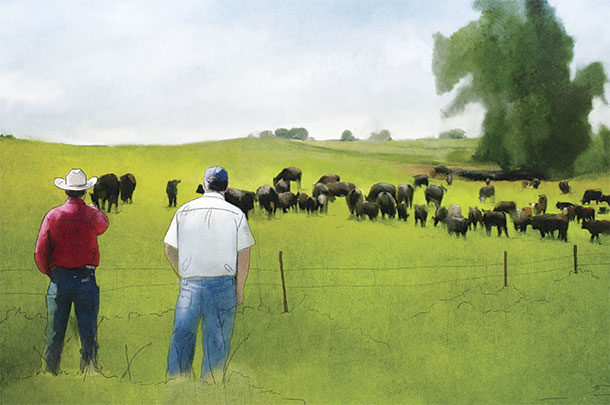Well, we studiously attend workshops, conferences and webinars that focus on technical skills and finances. We listen attentively, take notes, collect handouts, talk to each other in the hallways and then drive back to our farms and ranches. Then, we may try a couple of new things, maybe make a change or two.
So much new information – but has it really been effective? Hmmm. Does this suggest our outreach methods may be lacking? Could there be, perhaps, a better way (or at least a different way) that is more effective? Yes, there is. Let’s talk.
I’ve just described the standard approach to imparting new information: the classic lecture. We’ve all been to lectures many times. Nearly every class in school and college is designed around this model. Someone – a teacher, professor, lecturer, 4-H leader – stands in front of the group and talks about a topic. It’s the top-down approach. The speaker speaks; the listeners listen.
The speaker is really the only active person in the room; the listeners are passively taking notes. Chairs are generally arranged in orderly rows or in an amphitheater like a college auditorium. At the end of the session, there may be time for a few questions. Then everyone leaves the room, maybe hurrying to the next session.
Our agricultural workshops and conferences generally follow this same pattern (although, mercifully, without grades or surprise quizzes). And why not, since the speakers and event organizers were all trained in similar workshops? This top-down system is their comfort zone.
It’s almost like a Japanese kabuki play: The moves are formally prescribed; the script tightly written. No surprises. Everyone is comfortable within this system.
However, let’s ask ourselves a simple question: Do workshop attendees go home and actually make major changes in their management? I would submit that, except for a small minority of producers who like to try new things, most producers are very conservative, they don’t change much or often, and they continue doing what they’ve always been doing. It’s their comfort zone.
But if our current workshop system is not working well, do we have an alternative?
Yes, we do. There is a different way of learning – the “producer discussion group.” These groups have many names: producer group, forage group, discussion group, etc. But whatever you call them, they all share some common attributes, a common model. The group is composed of a limited number of members who are producers and other folks in agricultural roles.
The group meets regularly, maybe monthly. Members, who may or may not pay membership fees, can raise many different types of livestock, or they may all raise the same type of animals.
Producer group meetings include activities such as pasture walks, visits to farms and agricultural businesses, and most importantly, a time for discussion. There are no tests except the real ones in life when a producer talks to the banker. And the producer group has some sort of leader, usually a facilitator, who makes arrangements and keeps the meetings on track.
Although producer groups may vary in organizational details, they all share some core traits. These groups are, first and foremost, discussion groups. Members talk with one another about topics important to their operations. The communication style is multidirectional; it’s definitely not top-down.
Questions and comments fly back and forth between members and guests, among members and between the facilitator and others. But in a producer group, multiway communication is a highly prized value, not the exception, and guests usually get used to it.
Producer groups are quite common in countries like New Zealand and Australia. The reason is fairly simple: They work. Livestock producers who are members of these groups, particularly for a long time, tend to be profitable and stay in business.
Why are these operations more profitable? For one thing, they avoid wrecks. We all know about wrecks – those ideas that sounded so good when we first heard about them (perhaps at a workshop) but then didn’t quite work out on our place. Wrecks can cost a lot of money. For many operations, a couple of wrecks can be financially catastrophic.
Members of producer groups avoid wrecks because they can bounce off the new ideas with trusted group members. They get suggestions, feedback and warnings before they spend the money. They either avoid the wreck completely or modify their plans so the new thing works much better on their place. The producer group feedback helps them attain that higher productivity or increased efficiency without losing a lot of money in the attempt.
Another reason group members do better is: They are exposed to an ongoing reinforcement of new ideas, a kind of built-in support for new things. The members have judgments and experiences the member knows and trusts. There may be a couple of hundred years of experience in that room. You can’t buy feedback like that. The bottom line is: The member incorporates the new thing into his farm with confidence and minimal risk, and his system is better for it, more productive, more efficient and more profitable.
Group meetings also influence members in indirect ways. When a conversation focuses on the issues faced by one farm, all the members in the group listen to that conversation and internalize the comments. They each think of their own operation, how these issues may affect them and how they can solve those problems in their own way. This is a type of learning – very personal and very effective.
Communication, reinforcement, evaluation, discovery and praise – all healthy attributes of good discussions, month after month. And underlying all this structure, quietly inferred, is the enjoyment of belonging to an elite group of progressive livestock producers, of professional pride and growing understanding, of being helped by knowledgeable members and helping others.
Producer discussion groups – it’s a new comfort zone.








